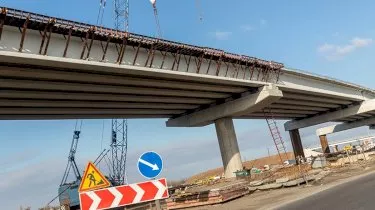Invest
Listed v unlisted infrastructure
Among the alternative assets available to investors, experts and funds pay special attention to infrastructure – real-world assets and structures that are vital to the economy.
Listed v unlisted infrastructure
Among the alternative assets available to investors, experts and funds pay special attention to infrastructure – real-world assets and structures that are vital to the economy.

Infrastructure refers to large real-world economic assets, such as bridges, railways, ports, schools and even facilities for basic utilities like water and electricity.
Investments in infrastructure may be used to build the physical structures or aid in keeping these assets operational.
What does investing in infrastructure mean?
Traditionally, investing in infrastructure referred to direct investing or holding privately held assets. Known as investments in unlisted infrastructure, this strategy allows investors to have direct influence over the structure for as long as they retain the shares in their portfolio.
However, this strategy has more recently been popularised as a form of alternative investment. An increasing number of investment managers and companies have made it more accessible to the public through the Australian Securities Exchange as listed infrastructure.

Listed infrastructure are similar with unlisted in the sense that they are both investments in infrastructure. But while unlisted infrastructure refers to direct investment in the asset, listed infrastructure are investments in an entity that manages a portfolio of one or more infrastructure.
Listed v unlisted infrastructure: Which is better?
Investors may choose between listed and unlisted infrastructure – the more appropriate choice would depend on their investment objectives and risk appetite.
Both types have been proven to be a valuable asset to growth investors over the long term
If you wish to invest in infrastructure, consider the following factors first:
Unlisted infrastructure
Ownership:
Unlisted infrastructure investments allow investors to directly hold a portion of the infrastructure, along with a proportion of its gains and cash flows.
Liquidity:
Infrastructure are illiquid assets and unlisted infrastructure retains this quality. Unlisted infrastructure gives good returns over the long term, but it may take a while to turn your investment into cash if you suddenly need to sell your portion.
Diversification:
You may be limited to what your money can buy because you are directly investing in infrastructure projects.
Risk:
Your portfolio will not see volatility with unlisted infrastructures because they are not valued daily and they generally increase in value over the long term. Since the underlying assets are essential structures for the economy, demand rarely goes down, which means returns are usually more stable.
However, increasing demand for unlisted infrastructure also sees choices decrease as fees increase.
Listed infrastructure
Ownership:
Listed infrastructure investments allow investors to own shares in an entity that owns and/or operates a portfolio of infrastructure. You may gain exposure to a variety of infrastructure within the portfolio, but you have no say in choosing which ones will be included.
Investing in listed infrastructure is similar to buying shares of a company that manages the structures – you have a stake on some company matters but not over the infrastructure themselves.
Liquidity:
Infrastructure are generally illiquid assets, but listed investments provide more liquidity to your portfolio because they can be traded in the ASX.
Diversification:
Underlying companies of listed infrastructure typically manage the selection of assets to invest in and the strategy to use. In many cases, the fund managers invest in a variety of assets in one portfolio, which means listed infrastructure are typically more diversified.
Risk:
Listed infrastructure are more exposed to volatility because they are traded in the sharemarket.
The underlying structures themselves are not valued daily and don’t experience volatility; however, the entity that offers the portfolio are more exposed to market sentiments.
If you wish to invest in infrastructure, make sure to do due diligence before adding them to your portfolio. Likewise, it’s recommended to seek the advice of a professional who can take your investment objectives into consideration.
Explore nestegg to learn more about investing.
About the author

About the author


Stock market
6K Additive secures A$48 million through initial public offering on the Australian Stock Exchange
6K Additive, a prominent player in the advanced metal powders and alloy additions market, has made a significant stride by successfully completing its Initial Public Offering (IPO) on the Australian ...Read more

Stock market
Institutional investors increase stock allocations to 18-year high amid cautious market shifts
In a recent development, State Street Markets unveiled the findings of its latest State Street Institutional Investor Indicators, revealing intriguing shifts in institutional investor behaviourRead more

Stock market
FOREX.com launches in Australia to empower self-directed traders
StoneX Group Inc. (NASDAQ: SNEX) has announced the Australian launch of FOREX.com, expanding access for self-directed traders to a global suite of Contracts for Difference (CFD) products across ...Read more

Stock market
Westpac and CMC Markets strengthen partnership to enhance online trading services
In a significant move that underscores the evolving landscape of online trading in Australia, CMC Markets Stockbroking has been chosen as the preferred vendor by Westpac Banking Corporation to extend ...Read more

Stock market
Portfolio reviews as an operating discipline: turning volatility into a competitive edge
In a higher-rate, higher-volatility world, portfolio reviews are no longer an annual hygiene task; they’re a core operating rhythm that protects cash flow, unlocks tax alpha, and sharpens risk ...Read more

Stock market
Fee war on the ASX: Global X’s A300 turns up the heat on core Aussie equity ETFs
Global X has lobbed a 0.04% management fee into Australia’s core equity sandbox, launching the Australia 300 ETF (A300) to take on entrenched giants. Read more

Stock market
Challenger IM shakes up the ASX with private credit note and a side of risk
Challenger Investment Management has taken private credit mainstream with an ASX-listed note structure—LiFTs—that secured roughly $100 million in cornerstone commitments within a day of launch. Read more

Stock market
International stocks: Diversifying your portfolio beyond Australia
In an increasingly globalized market, Australian investors have the opportunity to enhance their investment portfolio by incorporating international stocks. Diversifying your investments globally can ...Read more

Stock market
6K Additive secures A$48 million through initial public offering on the Australian Stock Exchange
6K Additive, a prominent player in the advanced metal powders and alloy additions market, has made a significant stride by successfully completing its Initial Public Offering (IPO) on the Australian ...Read more

Stock market
Institutional investors increase stock allocations to 18-year high amid cautious market shifts
In a recent development, State Street Markets unveiled the findings of its latest State Street Institutional Investor Indicators, revealing intriguing shifts in institutional investor behaviourRead more

Stock market
FOREX.com launches in Australia to empower self-directed traders
StoneX Group Inc. (NASDAQ: SNEX) has announced the Australian launch of FOREX.com, expanding access for self-directed traders to a global suite of Contracts for Difference (CFD) products across ...Read more

Stock market
Westpac and CMC Markets strengthen partnership to enhance online trading services
In a significant move that underscores the evolving landscape of online trading in Australia, CMC Markets Stockbroking has been chosen as the preferred vendor by Westpac Banking Corporation to extend ...Read more

Stock market
Portfolio reviews as an operating discipline: turning volatility into a competitive edge
In a higher-rate, higher-volatility world, portfolio reviews are no longer an annual hygiene task; they’re a core operating rhythm that protects cash flow, unlocks tax alpha, and sharpens risk ...Read more

Stock market
Fee war on the ASX: Global X’s A300 turns up the heat on core Aussie equity ETFs
Global X has lobbed a 0.04% management fee into Australia’s core equity sandbox, launching the Australia 300 ETF (A300) to take on entrenched giants. Read more

Stock market
Challenger IM shakes up the ASX with private credit note and a side of risk
Challenger Investment Management has taken private credit mainstream with an ASX-listed note structure—LiFTs—that secured roughly $100 million in cornerstone commitments within a day of launch. Read more

Stock market
International stocks: Diversifying your portfolio beyond Australia
In an increasingly globalized market, Australian investors have the opportunity to enhance their investment portfolio by incorporating international stocks. Diversifying your investments globally can ...Read more








